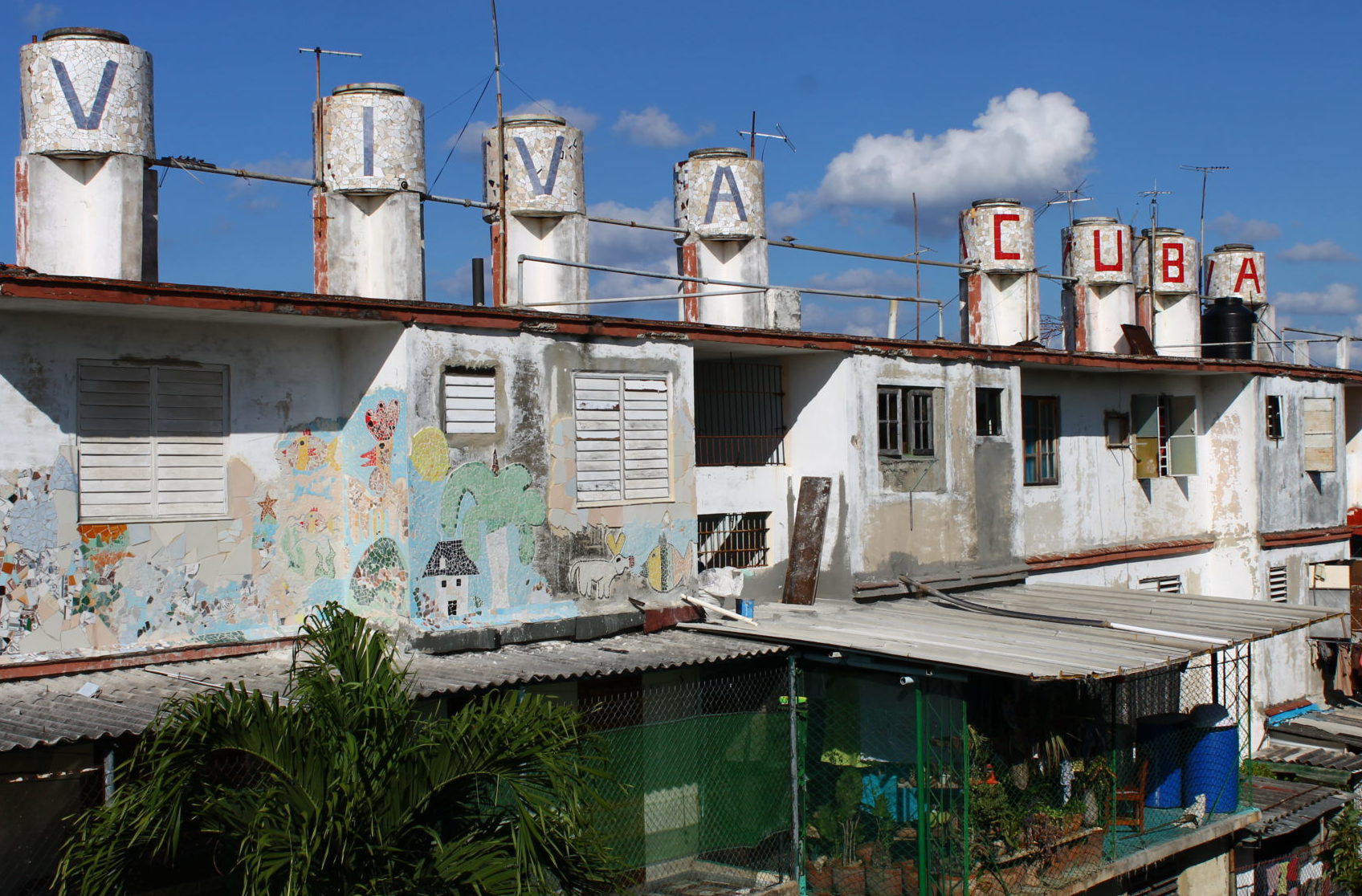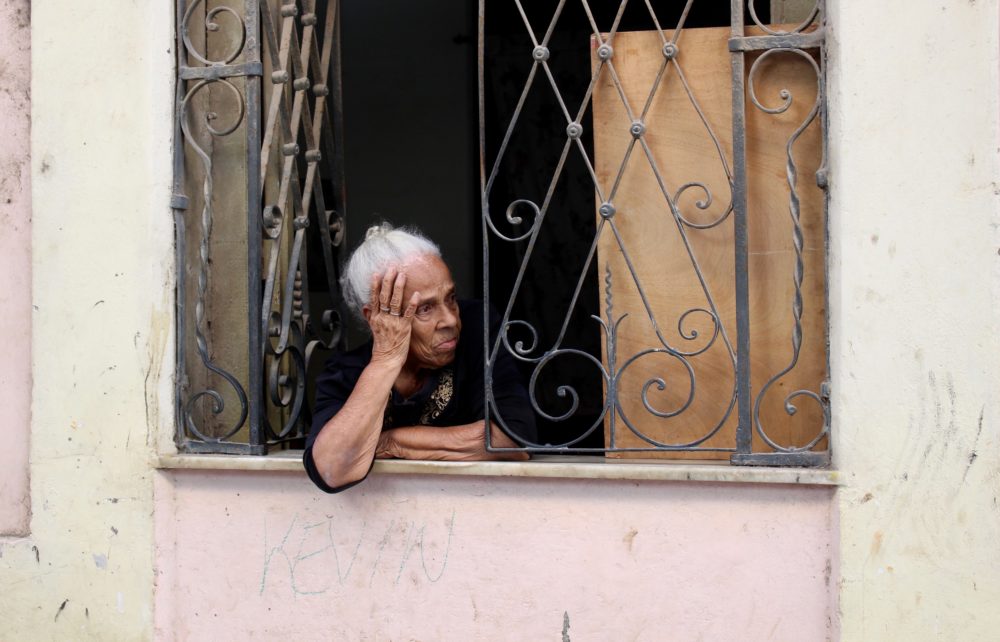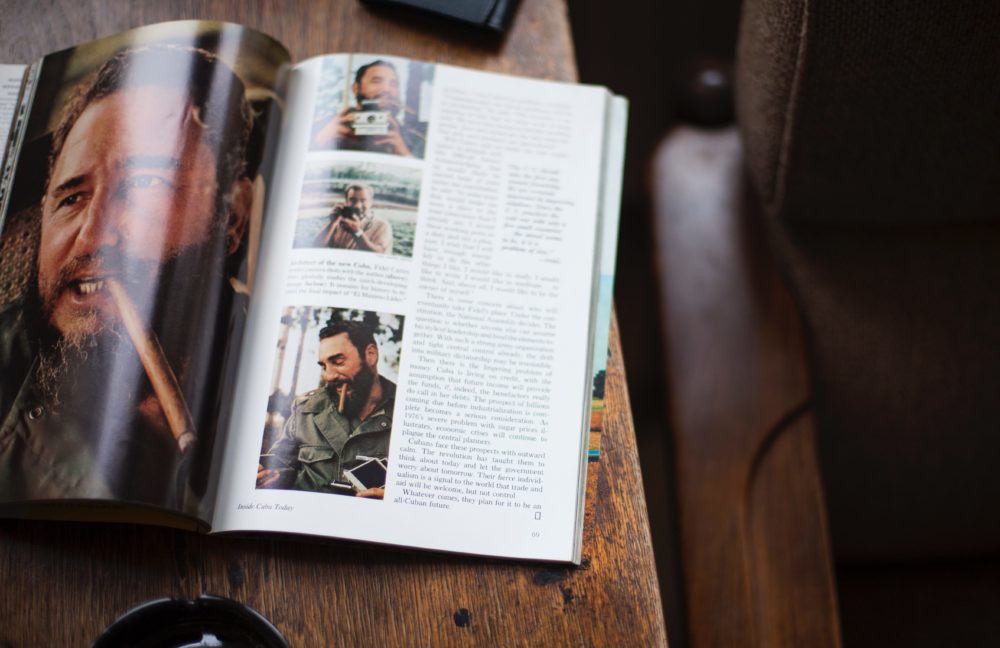There is a toothless banana seller outside of Vinales, a sleepy hamlet, four hours’ drive west of Havana. The old man’s banana cart sits on the side of a dead-end road, flanked by banana trees and vine-covered limestone towers, known as mogotes. A sign on the cart says, Nunca se es demasiado viejo para el amor—“Never too old for love.”
We’d driven by the cart on our way to see a music performance. I wanted a picture of the cart and I back-tracked alone, on foot, in the rain, to get it. The toothless man invited me to see his home. Our guide told us this was common in Cuba—a gesture of hospitality. She told us to take advantage of the opportunity should it present itself.
I followed the old man on the muddy trail. It led away from the cart into the trees, to the base of a mogote, where there was a small cave. It was littered with wooden crates and crumpled garbage. A blue blanket was piled in the corner. I searched for something to say.
“Where are you from?” he asked, breaking an awkward silence. His eyes lit up when I told him and he opened his arms for a hug. “Tienes un novio?” (Do you have a sweetheart?) He was at least 80 and, apparently, not too old for love.
I turned abruptly and slipped my way back down the muddy path to the road. The old man walked behind me as far as the cart and then handed me two clumps of bananas. “For your friends,” he said.
It was a spur of the moment decision to go to Cuba. People asked me, “Why?” I was surprised at first. The answer seemed obvious to me—the joy of exploring the unknown, the elation of a heartfelt connection with people who lead such different lives and yet are the same, deep down.
Even in November, Cuba is hot and humid. The buildings are fountains of color, sagging, decrepit and melting into the rough, pock-marked streets. At all times of day and night, music drifts from open windows, bars, and alleys, beating the Cuban salsa rhythm with the ever-present maraca and timbales.
On the street a smile is rarely unreturned. There is a joie de vivre in Cubans that some, I’ve read, attribute to the heat. People on the streets stare at our blonde hair and blue eyes. Some men are driven to approach and ask, “Where are you from?” Every single time, they smile in genuine surprise: “America? Really?”
Not many Americans have visited Cuba since Kennedy imposed travel restrictions in 1963, following the Cuban Missile Crisis. Trade restrictions have been in place since the late 1950s and early 1960s. The embargo prohibits American companies from exporting goods to Cuba and American travelers from visiting Cuba, without some hassle.
We are always warmly welcomed by these men who approach us on the streets. Sometimes they hug us or kiss us on the cheek. Sometimes they ask if they can have a photo with us. And always they stare and tell us how beautiful our eyes are. Machismo is the modus operandi of Cuban men. There was always a hand helping us out of the car, always someone offering to carry our suitcases.
Many of the men who approach us have family in the United States, mostly in Miami. It’s only with great effort that Cubans can visit America. We drive by the U.S. Interests Section (the fancy name for “consulate”) several times and always there is a long line of Cubans in what has become known as “the Park of Sorrows,” ready to submit paperwork for travel permits—paperwork that is frequently rejected. It is in the U.S. Interests Section, hopeful Cubans are judged to be fit for a visit, or not. The consideration however, takes time, although in 2014 the wait dropped from 57 months to just 5.
Havana is an enormous city. The population is more than 2 million, which makes the capital about the same size as Houston (the fourth largest city in the U.S.). Yet, the people treat each other as if they live in a small town. There is a consideration and respect that I’ve only rarely seen at home.
Here the pace of life seems slower. Few Cubans have cell phones, although the number is growing. Few have cable or the internet. In the city, tap water must be boiled, blackouts happen often, and cold showers are the norm. Farm machinery consists of wooden plows and oxen. In the country, transportation is often horse and cart rather than automobile. Instead of machines, they depend on each other.
Everyone here is guaranteed housing. There are no homeless sleeping on benches in the city’s many parks. The quality of the housing, however, is another matter. Running water is optional and “packed in like sardines” is a term used for some living situations. The buildings are old and unkempt—nearly every day, a building in Havana collapses, sometimes with people inside.
The city was built rapidly over a period of about 60 years, from around 1900 to Castro’s revolution in 1959. The depressed economy and lack of private ownership has prevented the buildings from being properly taken care of over the many decades since the revolution. With the help of UNESCO, Cuba’s government is restoring buildings, but can’t keep up as they’re all aging at a similar rate.
The conditions here though, are changing. Just a few weeks after my return, presidents Barack Obama and Raul Castro announced they were restoring ties. “Isn’t it wonderful? This is a dream come true!” our Cuban guide emailed from Havana. A few short months later, the White House announced the resumption of full diplomatic ties, with embassies in each other’s countries. “This is not merely symbolic. With this change, we will be able to substantially increase our contacts with the Cuban people,” President Obama announced.
Cuba is an island of color: the buildings, the classic cars, the lush jungles and golden beaches. It’s the poorest place I’ve ever been—an average Cuban survives on only $20 a month. Paradoxically, it’s also the happiest, most authentic place I’ve ever been. Cuba’s people are proud. They are a beautiful rainbow of experience, passion, resourcefulness, and liveliness.
I struggled to describe Cuba to my friends and family on my return. I still can’t describe to my satisfaction this place that, while there, brought me so much joy, laughter, and authenticity. It was as if I was reflecting the heart of this vibrant place, never too old for love, yet spurned for so long by its American neighbors.
[Featured image by author Julie Dunbar, who traveled to Cuba in 2014]



